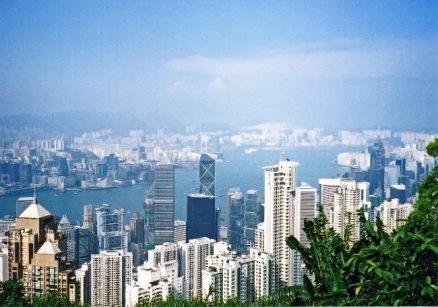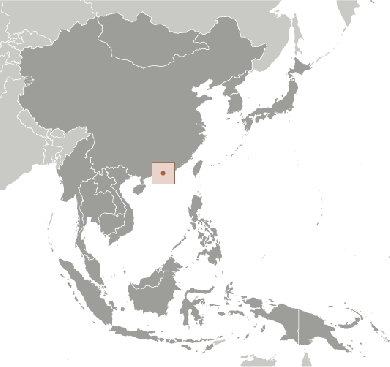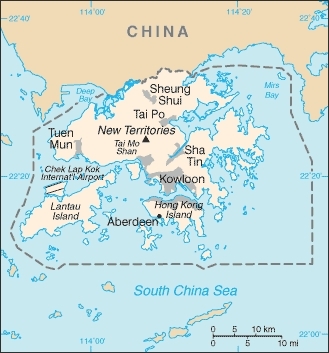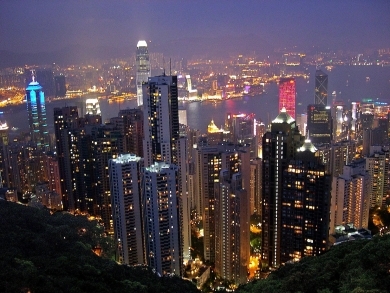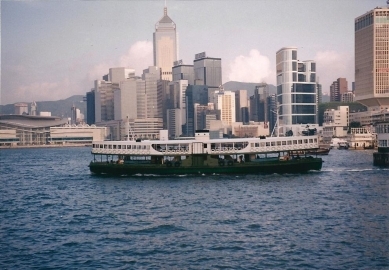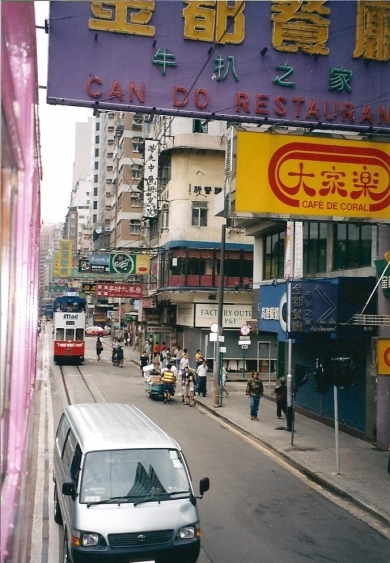Hong Kong
| Topics: |
Hong Kong is a Special Administrative Region of the People's Republic of China, composed of the New Territories, Kowloon Peninsula,
Hong Kong Island and more than 200 other islands, with over seven million people, borders the South China Sea.
Hong Kong is on the east side of thePearl River Delta, while Macau, another Special Administrative Region, is on the western side.
Its major environmental issues include air and water pollution from rapid urbanization. Hong Kong is susceptible to occasional typhoons.
Occupied by the UK in 1841, Hong Kong was formally ceded by China the following year; various adjacent lands were added later in the 19th century.
Pursuant to an agreement signed by China and the UK on 19 December 1984, Hong Kong became the Hong Kong Special Administrative Region (SAR) of the People's Republic of China on 1 July 1997. In this agreement, China promised that, under its "one country, two systems" formula, China's socialist economic system would not be imposed on Hong Kong and that Hong Kong would enjoy a high degree of autonomy in all matters except foreign and defense affairs for the next 50 years.
Contents
Geography
Location: Eastern Asia, bordering the South China Sea and China
Geographic Coordinates: 22 15 N, 114 10 E
Area: 1,104 sq km (land: 1,054 sq km; water: 50 sq km)
Land Boundaries: 30 km with China.
Coastline: 733 km
Maritime Claims:
territorial sea: 3 nm
Natural Hazards:
Terrain: hilly to mountainous with steep slopes; lowlands in north. The highest point is Tai Mo Shan (958 m).
Climate: subtropical monsoon; cool and humid in winter, hot and rainy from spring through summer, warm and sunny in fall
Ecology and Biodiversity
Ecologically Hong Kong isincluded within the South China-Vietnam subtropical evergreen forests ecoregion extends from northern Vietnam into southeastern China, including Hainan Island.
See also: South China Sea large marine ecosystem
| Nighttime view of Hong Kong. |
| A Hong Kong Star Ferry. |
| Hong Kong street scene. |
People and Society
Population: 7,153,519 (July 2012 est.)
Hong Kong's population has increased steadily over the past decade, reaching 7.097 million in 2010. Hong Kong is one of the most densely populated areas in the world, with an overall density of some 6,426 people per square kilometer. Cantonese, the official Chinese dialect in Hong Kong, is spoken by most of the population. English, also an official language, is widely understood and is spoken by more than one-third of the population. Every major religion is practiced freely in Hong Kong. All children are required by law to be in full-time education between the ages of 6 and 15. Starting in 2008, the Hong Kong Government expanded the length of free education it offers from 9 to 12 years. Preschool education for most children begins at age 3. Primary school begins normally at age 6 and lasts for 6 years. At about age 12, children progress to a 3-year course of junior secondary education; at age 15, they can choose to continue with 3-year senior secondary education or to join full-time vocational training. More than 90% of children complete upper secondary education or equivalent vocational education. In 2010, 301,200 students were enrolled in post-secondary education. Over 25.5% of the total population aged 15 and over have attended post-secondary educational institutions..
Ethnic Groups: Chinese 95%, Filipino 1.6%, Indonesian 1.3%, other 2.1% (2006 census)
Age Structure:
0-14 years: 11.6% (male 431,728/female 394,898)
15-64 years: 74.8% (male 2,573,929/female 2,757,095)
65 years and over: 13.5% (male 452,278/female 512,580) (2011 est.)
Population Growth Rate: 0.421% (2012 est.)
Birthrate: 7.54 births/1,000 population (2012 est.)
Death Rate: 7.23 deaths/1,000 population (July 2012 est.)
Net Migration Rate: 3.9 migrant(s)/1,000 population (2012 est.)
Life Expectancy at Birth: 82.12 years (2012 est.)
Total Fertility Rate: 1.09 children born/woman (2012 est.)
Languages: Cantonese (official) 90.8%, English (official) 2.8%, Putonghua (Mandarin) 0.9%, other Chinese dialects 4.4%, other 1.1% (2006 census)
Literacy (age 15 and over can read and write): 93.7% (2002)
Urbanization: 100% of total population (2010)
History
According to archaeological studies, human activity on Hong Kong dates back over five millennia. Excavated neolithic artifacts suggest an influence from northern Chinese stone-age cultures.
The territory was settled by Han Chinese during the seventh century, A.D., evidenced by the discovery of an ancient tomb at Lei Cheung Uk in Kowloon. The first major migration from northern China to Hong Kong occurred during the Sung Dynasty (960-1279).
The British East India Company made the first successful sea venture to China in 1699, and Hong Kong's trade with British merchants developed rapidly soon after.
After the Chinese defeat in the First Opium War (1839-42), Hong Kong was ceded to Britain in 1842 under the Treaty of Nanking. Britain was granted a perpetual lease on the Kowloon Peninsula under the 1860 Convention of Beijing, which formally ended hostilities in the Second Opium War (1856-58). The United Kingdom, concerned that Hong Kong could not be defended unless surrounding areas also were under British control, executed a 99-year lease of the New Territories in 1898, significantly expanding the size of the Hong Kong colony.
In the late 19th century and early 20th centuries, Hong Kong developed as a warehousing and distribution center for U.K. trade with southern China. After the end of World War II and the communist takeover of Mainland China in 1949, hundreds of thousands of people fled from China to Hong Kong.
Hong Kong became an economic success and a manufacturing, commercial, finance, and tourism center. High life expectancy, literacy, per capita income, and other socioeconomic measures attest to Hong Kong's achievements over the last 5 decades.
On July 1, 1997, China resumed the exercise of sovereignty over Hong Kong, ending more than 150 years of British colonial rule. Hong Kong is a Special Administrative Region of the People's Republic of China with a high degree of autonomy in all matters except foreign and defense affairs. According to the Sino-British Joint Declaration (1984) and the Basic Law, Hong Kong will retain its political, economic, and judicial systems and unique way of life for 50 years after reversion and will continue to participate in international agreements and organizations under the name, "Hong Kong, China."
Government
Dependency Status/Government Type: special administrative region of China with limited democracy
The Hong Kong Special Administrative Region (SAR) is headed by Chief Executive Donald Tsang Yam-kuen, who first took office in 2005. Tsang won re-election in 2007, running against Alan Leong Kah-kit, a senior barrister and legislator for the pan-democratic Civic Party. Tsang's current term ends in 2012. The Election Committee that votes on the Chief Executive (CE) is made up of approximately 1,200 Hong Kong residents from four constituency groups: commercial, industrial, and financial interests; professionals; labor, social services, and religious interests; and the legislature, the Chinese People's Political Consultative Conference, and the P.R.C. National People's Congress.
In July 2002, the Hong Kong Government implemented the Principal Officials Accountability System, which was designed to make the government more responsive to public concerns. Twelve political appointees, directly responsible to the Chief Executive, run the 12 policy bureaus. Three other senior civil service positions--the Chief Secretary, Financial Secretary, and Justice Secretary--are also filled by political appointments. This system expanded in 2008 to include one Under Secretary and one Political Assistant position filled by appointment in each bureau.
Hong Kong remains a free and open society where human rights are respected, courts are independent, and there is well-established respect for the rule of law. However, the right of residents to change their government peacefully is limited by the Basic Law, which provides for the selection of the CE by an 800-person Election Committee composed of individuals who are directly elected, indirectly elected, and appointed (expanded to 1,200 for 2012). The Basic Law provides for the direct election of 30 of the 60 LegCo members. The other 30 seats in the LegCo are elected by 28 functional constituencies (FCs), which represent key economic and social sectors. As of 2008, the 28 FCs represented fewer voters than the electorate in a single geographic constituency. The vast majority of FC voters are represented by the three largest FCs, while the four smallest have fewer than 200 voters. FCs set their own voting rules, with some allowing heads of corporations to vote on behalf of their companies. Persons with interests in more than one sector represented by an FC may be able to cast three or more votes (one in their geographic constituency and one in each FC for which they meet eligibility requirements). In 2007 the CE Election Committee selected incumbent Donald Tsang Yam-kuen, and the P.R.C.'s State Council formally appointed him. In September 2008 voters in six geographic constituencies elected 30 legislators, half of the total LegCo, in elections that were generally free and fair.
Administrative divisions:
Legal System: mixed legal system of common law based on the English model and Chinese customary law (in matters of family and land tenure)
International Environmental Agreements
According to Article 13 of the Basic Law, Hong Kong's foreign relations and defense are the responsibility of China. However, Hong Kong is a customs territory and economic entity separate from the rest of China and is able to enter into international agreements on its own behalf in commercial and economic matters. Hong Kong, independently of China, participates as a full member of numerous international economic organizations including the World Trade Organization (WTO), the Asia Pacific Economic Cooperation forum (APEC), and the Financial Action Task Force (FATF). It is an articulate and effective champion of free markets and the reduction of trade barriers.
Hong Kong is party to international agrements on: Marine Dumping (associate member), Ship Pollution (associate member)
Resources
Natural Resources: outstanding deepwater harbor, feldspar
Land Use:
arable land: 5.05%
permanent crops: 1.01%
other: 93.94% (2001)
Economy
Hong Kong has a free market economy highly dependent on international trade and finance - the value of goods and services trade, including the sizable share of re-exports, is about four times GDP.
Hong Kong's open economy left it exposed to the global economic slowdown that began in 2008.
Although increasing integration with China, through trade, tourism, and financial links, helped it to make an initial recovery more quickly than many observers anticipated, it again faces a possible slowdown as exports to the Euro zone and US slump.
The Hong Kong government is promoting the Special Administrative Region (SAR) as the site for Chinese renminbi (RMB) internationalization. Hong Kong residents are allowed to establish RMB-denominated savings accounts; RMB-denominated corporate and Chinese government bonds have been issued in Hong Kong; and RMB trade settlement is allowed. The territory far exceeded the RMB conversion quota set by Beijing for trade settlements in 2010 due to the growth of earnings from exports to the mainland. RMB deposits grew to roughly 4.6% of total system deposits in Hong Kong by the end of 2010, an increase of over 392% since the beginning of the year. The government is pursuing efforts to introduce additional use of RMB in Hong Kong financial markets and is seeking to expand the RMB quota.
The mainland has long been Hong Kong's largest trading partner, accounting for about half of Hong Kong's exports by value. Hong Kong's natural resources are limited, and food and raw materials must be imported.
As a result of China's easing of travel restrictions, the number of mainland tourists to the territory has surged from 4.5 million in 2001 to 20 million in 2011, outnumbering visitors from all other countries combined. Hong Kong has also established itself as the premier stock market for Chinese firms seeking to list abroad. In 2010 mainland Chinese companies constituted about 19% of the firms listed on the Hong Kong Stock Exchange and accounted for 62% of the Exchange's market capitalization.
During the past decade, as Hong Kong's manufacturing industry moved to the mainland, its service industry has grown rapidly. Growth slowed to 5% in 2011.
Credit expansion and tight housing supply conditions caused Hong Kong property prices to rise rapidly in 2010 and inflation to rise over 5% in 2011. Lower and middle income segments of the population are increasingly unable to afford adequate housing.
Hong Kong continues to link its currency closely to the US dollar, maintaining an arrangement established in 1983.
GDP: (Purchasing Power Parity): $353.7 billion (2011 est.)
GDP: (Official Exchange Rate): $246.9 billion (2011 est.)
GDP- per capita (PPP): $49,300 (2011 est.) - the 9th highest in the world and slightly higher than the United States
GDP- composition by sector:
agriculture: 0%
industry: 7%
services: 92.6% (2011 est.)
Agricultural products: fresh vegetables; poultry, pork; fish
Industries: textiles, clothing, tourism, banking, shipping, electronics, plastics, toys, watches, clocks
Currency: Hong Kong dollars (HKD)
This simulated natural color image is a mosaic of 4 ASTER scenes, acquired October 2 and November 3, 2003. The scenes are located at 22.3 degrees North, 114.2 degrees East. The image covers an area of 53.7 x 56.6 km. Source: NASA/GSFC/METI/ERSDAC/JAROS, and U.S./Japan ASTER Science Team
